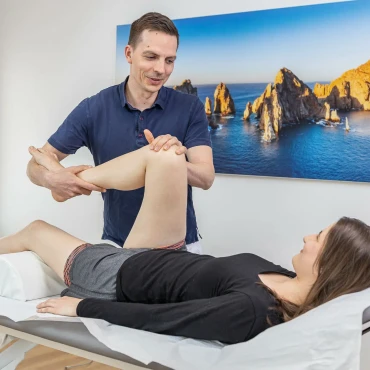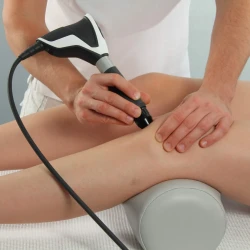Osteoarthritis of the knee - knee pain is extremely stressful for affected patients
Are you aware that osteoarthritis is the most common joint disease in the world? In the past, osteoarthritis was primarily considered a mechanical problem. Today, however, we know that it is primarily an inflammatory disease of the soft tissue in and around the affected joint. This results in
increased wear and tear and ultimately the destruction of the cartilage layer in the joint. As a result, the bone ends that meet are no longer sufficiently cushioned and cushioned so that, in the worst case, they rub against each other without protection.
Almost any joint can suffer from osteoarthritis or arthritis
Osteoarthritis can affect a wide variety of joints. Statistically speaking, knee osteoarthritis and hip osteoarthritis are particularly common. However, quite a few patients also visit us because they have symptoms of osteoarthritis in the shoulder, ankle, facet joints of the spine or other joints.
A look at the factors that trigger osteoarthritis in the knee joint
According to current findings, long-term chronic joint inflammation is a primary causative factor for the development of osteoarthritis. This chronic inflammation, often referred to as "silent inflammation", leads to an imbalance between cartilage formation and degradation, which often causes the increased wear and tear of the cartilage in osteoarthritis. However, in some patients, especially younger ones, osteoarthritis can also occur as a result of a sports injury, rheumatic disease or genetic cartilage degeneration. Obesity, lack of exercise, stress and lack of sleep as well as frequent overloading, metabolic disorders, poor posture and advanced age are further significant risk factors for the development of osteoarthritis.


Book a consultation appointment now!
A quick, simple and easy way to your appointment.
Osteoarthritis symptoms begin gradually and become more intense in phases
Depending on the stage and progression of your osteoarthritis, you may suffer from pain and discomfort of varying intensity. In the early stages, osteoarthritis of the knee joint manifests itself primarily through knee pain during impact-like movements such as jumping or jogging. If the cartilage wear in the joint progresses or if the inflammatory process in the joint capsule and joint mucosa is activated for other reasons, pain at rest, joint pain at night, pain at the start of a movement and a feeling of tension in the joint can also occur, up to and including joint stiffness.
Osteoarthritis of the knee always has an impact on the entire body
Over time, osteoarthritis of the knee joint does not remain without effects on the entire body. The pathological processes in the joint not only affect the joint surfaces, but also surrounding structures such as bones, muscles, tendons, ligaments and tissue. Over time, these changes result in incorrect loads, relieving postures and disturbances in the body's movement patterns. This means that osteoarthritis of the knee joint does not only affect the affected joint, but also influences the overall body statics. This can lead to damage and complaints in other areas, including wear and tear of vertebral joints or intervertebral discs, due to the resulting incorrect loads.
The course of the disease makes early osteoarthritis treatment essential
Osteoarthritis can be more severe or less severe. It is important to emphasize that this disease begins gradually, regardless of the joint affected. It often progresses subtly at the beginning and only causes severe pain, movement disorders or problems with the joint's load-bearing capacity at an advanced stage. Thanks to the latest findings on the development of osteoarthritis and modern regenerative treatment methods, we can now significantly delay the progression of the disease and often effectively alleviate the symptoms even in advanced stages. Nevertheless, once degeneration of the joint cartilage has begun, it is currently not completely reversible.
This makes prevention and therapeutic concepts that place great emphasis on treating the underlying inflammatory process in the early stages of knee osteoarthritis all the more important:
- The first step is to strive for a lifestyle that is as anti-inflammatory as possible, taking into account the following aspects: a high-fiber, low-carbohydrate Mediterranean diet, a balanced amount of exercise, effective stress management and sufficient sleep.
- Therapeutically, the first step, depending on the degree of osteoarthritis and the acute activation state, is to reduce the acute irritation. Cold therapy, laser therapy and kinesio tape are possible therapeutic approaches here.
- The second step focuses on activating the regenerative processes. This affects the area of the cartilage as well as the underlying, often overloaded bone, the capsule-ligament apparatus surrounding the joint, which has been altered by inflammation, and the joint mucosa. Focused shock waves, the high-energy magnetic field (EMTT) and injections of plasma from the patient's own blood and high-molecular hyaluronic acid are used here.
- At the same time, it is very important to restore the function of the surrounding muscle and fascia system and to correct static dysfunctions, incorrect posture and muscular imbalances that lead to increased joint stress. Osteopathic treatments, myofascial therapies using radial shock wave therapy, fascia therapy, individual exercises, repetitive peripheral muscle stimulation and, if necessary, manual therapy as part of physiotherapy treatment are used here.
- The third and final step is to precisely identify and counteract any remaining unfavorable movement patterns, muscular imbalances, poor posture and incorrect strain. To this end, we carry out a comprehensive posture and movement analysis in our High-Performance Motionlab. Based on the knowledge gained from this, you can undergo customized neuromuscular training therapy with us. We can also create an individual exercise plan for you or make recommendations for the effective design of your supplementary physiotherapy.
Further links, sources and literature references on the treatment of osteoarthritis:
-
An update on the pathophysiology of osteoarthritis
-
Innate Inflammation and Synovial Macrophages in Osteoarthritis Pathophysiology
-
Extracorporeal Shock Wave Therapy for the Treatment of Osteoarthritis: A Systematic Review and Meta-Analysis
-
A Randomized Controlled Trial on the Effects of Low-Dose Extracorporeal Shockwave Therapy in Patients With Knee Osteoarthritis
-
The efficacy and safety of extracorporeal shockwave therapy in knee osteoarthritis: A systematic review and meta-analysis
-
Efficacy of Intra-articular Platelet-Rich Plasma Injections in Knee Osteoarthritis: A Systematic Review
-
Intra-articular platelet-rich plasma injections versus intra-articular corticosteroid injections for symptomatic management of knee osteoarthritis: systematic review and meta-analysis
-
Intra-articular conservative therapy methods for hip and knee joint arthrosis

